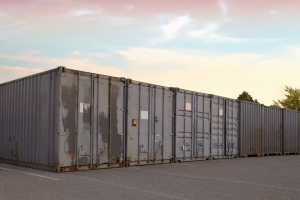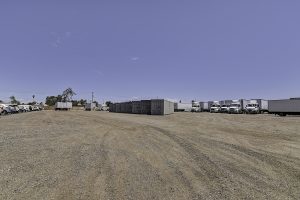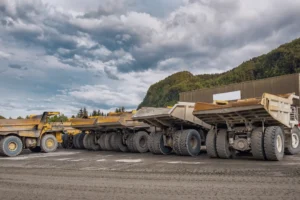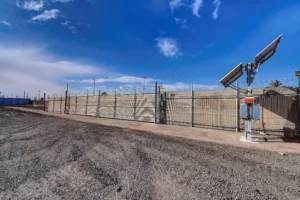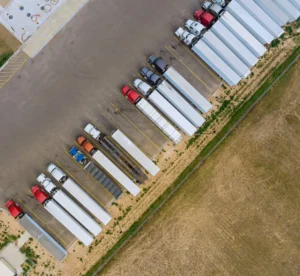Secure 24/7 commercial transport storage provides fleets and heavy-equipment operators continuous, controlled access to outdoor yard space designed for staging, long-term storage, and rapid dispatch. This article explains why always-available access matters, how security systems and amenities reduce operational friction, and which leasing models suit different fleet strategies. Operators wrestling with night-time staging, irregular dispatch windows, or limited depot space will learn practical selection criteria for industrial outdoor storage, including ground requirements and vehicle footprints. Property owners and investors will also find a clear pathway to develop or lease land for industrial outdoor storage with realistic partnership steps and revenue considerations. The sections that follow cover the benefits of round-the-clock truck parking, the range of vehicles supported, lease model comparisons, a localized review of convenience and security in Phoenix, amenities that matter, and how owners can partner to convert land into productive industrial outdoor storage.
What Are the Benefits of 24/7 Secure Commercial Truck Parking?

24/7 secure commercial truck parking reduces operational downtime, lowers asset-risk exposure, and increases scheduling flexibility by combining continuous access with hardened perimeter controls. Fleets that stage equipment overnight or require off-hour loading benefit from reduced deadhead miles and faster driver turnover because vehicles are ready when dispatch demands arise. Financially, secure yards can reduce insurance risk and potential replacement costs by lowering theft and vandalism incidence, while enabling fleets to avoid fines for illegal curbside parking or zoning violations by keeping assets in a compliant facility. Operationally, always-on access supports split-shift drivers, emergency dispatch scenarios, and flexible logistic windows that align with late-night or early-morning loading schedules. Understanding how specific security features produce measurable benefits helps fleet managers evaluate providers and select sites that match operational tempo and risk tolerance.
This list highlights core, measurable benefits fleets see with 24/7 secure commercial truck parking:
- Reduced Asset Loss: Continuous monitoring and controlled access decrease theft and vandalism incidents.
- Improved Dispatch Flexibility: Always-available parking allows rapid deployment across shifts and off-hour jobs.
- Lower Operational Costs: Fewer deadhead miles and avoidance of penalties cut operating expenses.
- Insurance & Compliance Advantages: Hardened sites often support favorable underwriting and regulatory compliance.
These benefits create operational resilience for fleets and make choosing the right storage model a strategic decision tied directly to security features and access policies.
Security features translate directly into practical benefits for fleets. The table below maps common security components to the operational value they deliver and a measurable impact you can track when evaluating sites.
| Security Feature | Function | Operational Benefit |
|---|---|---|
| Live camera stream | 24/7 visual monitoring with remote access | Reduces theft risk and enables real-time incident verification |
| Individual renter codes | Unique access credentials per tenant | Prevents unauthorized entry and simplifies access audits |
| Automated gates | Controlled vehicle ingress/egress | Limits unauthorized traffic and logs entries for security events |
How Does 24/7 Surveillance Enhance Fleet Storage Security?
Continuous surveillance uses a combination of live camera streams, event-based recording, and remote access controls to detect and document unauthorized activity, and it supports quick response workflows that limit loss. Modern systems stream footage to secured servers and retain records for investigations, allowing fleet managers and insurers to verify events and accelerate claims. Alerting and motion detection integrate with lighting and gate controls so that detected movement triggers both illumination and review, deterring opportunistic tampering. Surveillance data also enables trend analysis—showing hotspots or repeated access times—so operators can adjust patrols, lighting, or access policies to mitigate risk. Effective surveillance therefore couples technology with operational procedures to produce measurable reductions in theft and vandalism incidents, improving both security outcomes and insurance positioning.
Why Is Flexible Access Important for Commercial Transport Storage?
Flexible access matters because real-world dispatch windows rarely align with standard business hours; night deliveries, emergency re-routes, and staggered crew start times require facilities that match operational rhythms. When drivers can access yards at any hour using secure credential systems, fleets reduce wait times at terminals and minimize unpaid idle hours, which directly affects productivity and driver satisfaction. Access mechanisms such as individual renter codes and automated gates maintain security while enabling flexibility: credentials can be provisioned, revoked, or time-limited to support contractors or temporary users. Choosing 24/7 access should balance operational gains with security controls; the ideal provider offers both continuous entry and robust audit trails so managers can control risk without sacrificing agility.
Which Vehicles and Equipment Can You Store in Industrial Outdoor Storage Yards?
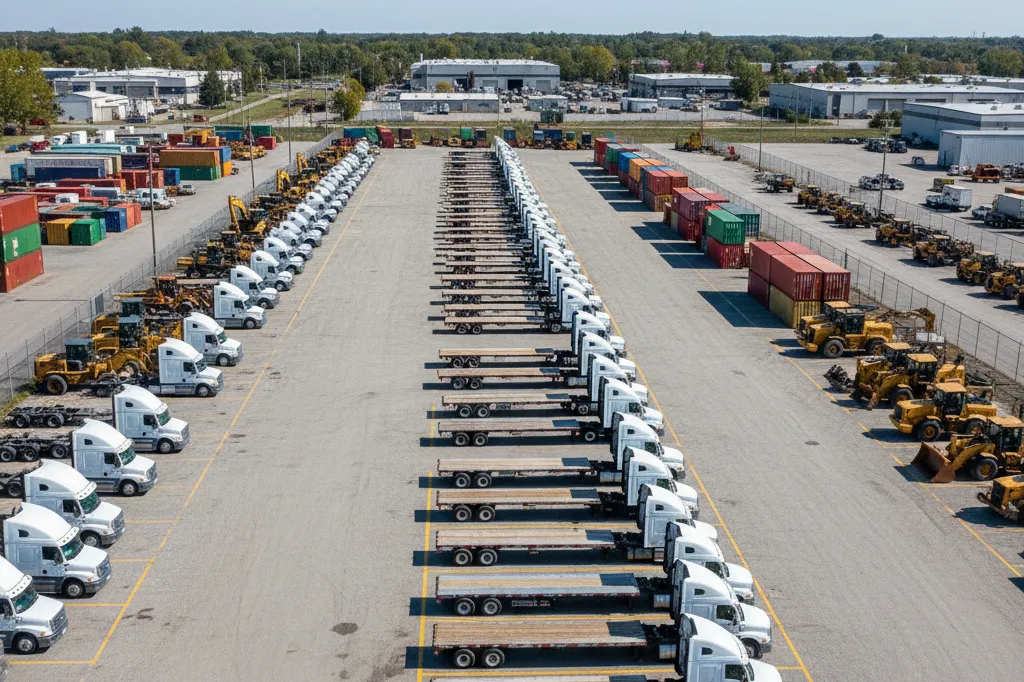
Industrial outdoor storage yards support a wide range of commercial vehicles and heavy equipment, from long-haul semi-trucks and trailers to containers, construction machinery, and larger recreational vehicles used by contractors. These yards are engineered to accommodate different footprints and turning radiuses, and they apply storage rules for spacing, weight distribution, and safe ingress/egress to protect both assets and the ground surface. Vehicle-specific handling practices—staging patterns for trailers, laydown areas for heavy machinery, and stacking or placement rules for containers—ensure efficient use of space while maintaining operational safety. Site selection should therefore consider surface type, load-bearing capacity, and available circulation space to match the intended mix of assets.
The following list summarizes common vehicle and equipment categories typically supported in industrial outdoor storage yards:
- Semi-trucks and tractor-trailers: Require long bays and wide turning radiuses for ingress and staging.
- Trailers (empty or staged): Benefit from linear parking patterns and easy hook-up access.
- Heavy equipment (dozers, excavators): Need reinforced surfaces and laydown zones for safe storage.
These categories represent typical hyponyms under the broader industrial storage class; understanding each type’s storage footprint and handling needs helps managers choose the right yard and organize assets for fast deployment.
Before the detailed examples below, this table lists vehicle-type requirements and operational notes for planners comparing yard suitability.
| Vehicle / Equipment | Storage Requirement | Notes |
|---|---|---|
| Semi-truck / Tractor-trailer | 12–14 ft wide lanes; long linear bays | Provide clear turning radiuses and staging lanes |
| Trailers | Level, compacted surface; accessible hook-up points | Staged trailers need sequential access to avoid rehandling |
| Heavy equipment | Reinforced pads or compacted base | Avoid soft surfaces; plan for maintenance access |
What Types of Commercial Vehicles Are Supported?
Commercial outdoor storage yards routinely accept semi-trucks, trailers, fleet vans, and contractor vehicles, each with distinct parking footprints and operational demands that affect layout design. Semi-trucks require elongated stalls or linear parking patterns to facilitate safe entrances and exits, while standalone trailers often need staging rows that allow sequential access without moving adjacent units. Light commercial vans and smaller service vehicles fit into denser zones but still require clear circulation paths for loading and driver access. Yard managers typically zone areas by vehicle class, using reinforced surfacing for heavy units and more compact paddocks for smaller fleet vehicles to optimize space and minimize interference between different vehicle classes. These zoning decisions reduce handling time and simplify fleet administration.
How Is Heavy Equipment and Shipping Container Storage Managed?
Heavy equipment and shipping container storage are managed by combining appropriate ground preparation, spacing rules, and handling protocols to protect both assets and the site infrastructure. Sites designate laydown pads with compacted aggregates or reinforced surfaces for tracked and wheeled machinery, and they allocate clear lifting and loading zones for containers that require forklifts or cranes. Spacing standards prevent overstacking and allow safe access for maintenance, refueling, and inspections; these rules also ensure weight is distributed to avoid rutting or subsidence on softer soils. Regular inventory checks and inspection routines reduce the likelihood of unnoticed damage and help operators schedule maintenance or repositioning to preserve operational readiness.
How Do Flexible Leasing Options Support Commercial Transport Storage Needs?
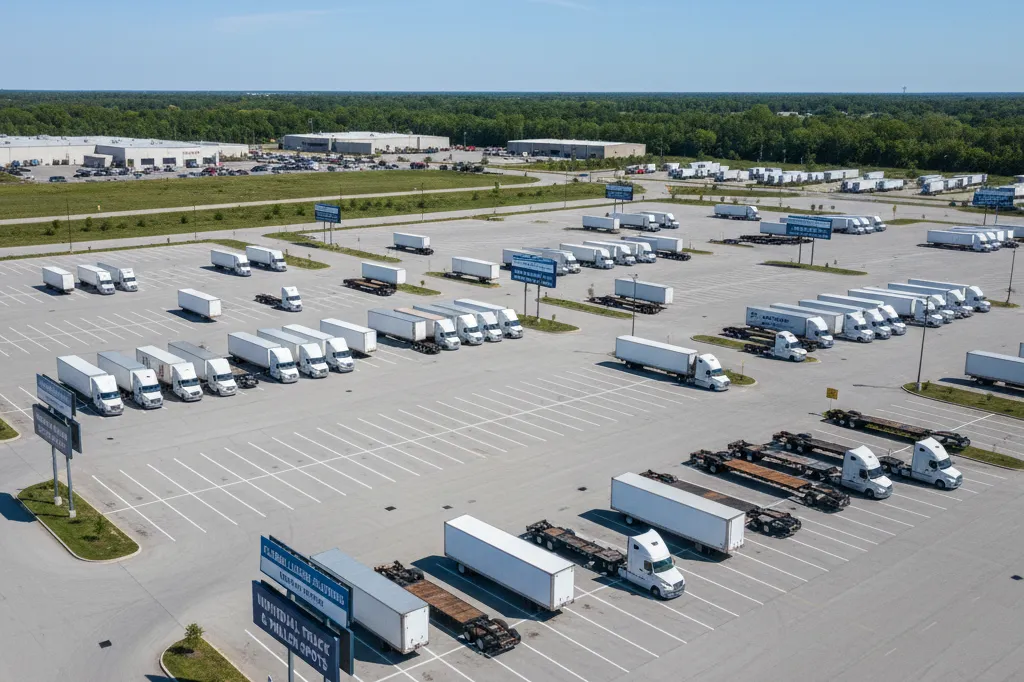
Flexible leasing models let fleets and businesses align capacity with demand by choosing lease-by-acre arrangements, individual parking spots, or short-term month-to-month options depending on scale and predictability of need. Lease-by-acre suits large fleets that require consistent, exclusive space and prefer simplified administration and on-site control; individual spot leasing fits operators with smaller fleets or variable footprint needs; short-term and month-to-month leases deliver temporary capacity for project spikes or seasonal surges. Understanding cost/benefit trade-offs and matching lease structure to operational patterns helps managers avoid paying for unused space while maintaining the ability to scale quickly. Compare lease types by evaluating administration complexity, access control needs, and the predictability of storage demand to select the most cost-effective model.
Below is a comparison table that distinguishes common lease types by use case and expected cost/benefit profile to aid decision-making.
| Lease Type | Typical Use Case | Cost / Benefit |
|---|---|---|
| Lease by acre | Large fleets needing dedicated space | Higher upfront cost, simpler administration, scalable staging |
| Individual parking spots | Small fleets or fixed-count parking | Cost-efficient for predictable small fleets, easy to manage |
| Short-term / month-to-month | Seasonal spikes, projects, overflow | Flexible cost structure, minimal commitment, higher per-unit rate |
Paddock Parking offers a range of leasing formats that reflect these models, including lease by acre, short-term, and month-to-month options that let operators scale space quickly without long-term commitments. These options accommodate semi-trucks, trailers, heavy equipment, containers, and RVs, and they are designed to match varied fleet strategies while simplifying administration and access control for tenants.
What Are the Advantages of Lease by Acre vs. Individual Parking Spots?
Lease-by-acre arrangements provide scale and predictability for large fleets, offering dedicated staging areas, easier internal site management, and the opportunity to configure yard layouts to specific workflow needs. This model reduces day-to-day coordination with the facility operator and can lower handling time for frequent operations by providing contiguous space for related assets. Conversely, individual parking spots are more cost-effective for smaller operators who prefer pay-for-what-you-use economics and minimal administrative overhead. Spots allow precise capacity matching and are often simpler to manage from an accounting perspective, but they may require more coordination during peak demand periods. Deciding between these models requires weighing scale benefits and site control against per-unit costs and flexibility needs.
Is Short-Term and Month-to-Month Leasing Available for Fleets?
Short-term and month-to-month leases are ideal for project-based work, seasonal demand, or temporary overflow needs because they provide immediate capacity without extended commitments and often require minimal onboarding. These arrangements let fleets respond to sudden contract wins or seasonal peaks by acquiring space quickly, and they reduce the financial risk of underused long-term leases. Operationally, short-term tenants should confirm minimum notice periods, access provisioning times, and any temporary credentialing processes that affect deployment speed. When used strategically, flexible terms increase fleet agility and prevent capacity shortfalls during unpredictable demand cycles.
How Does Paddock Parking Ensure Security and Convenience in Phoenix, AZ?
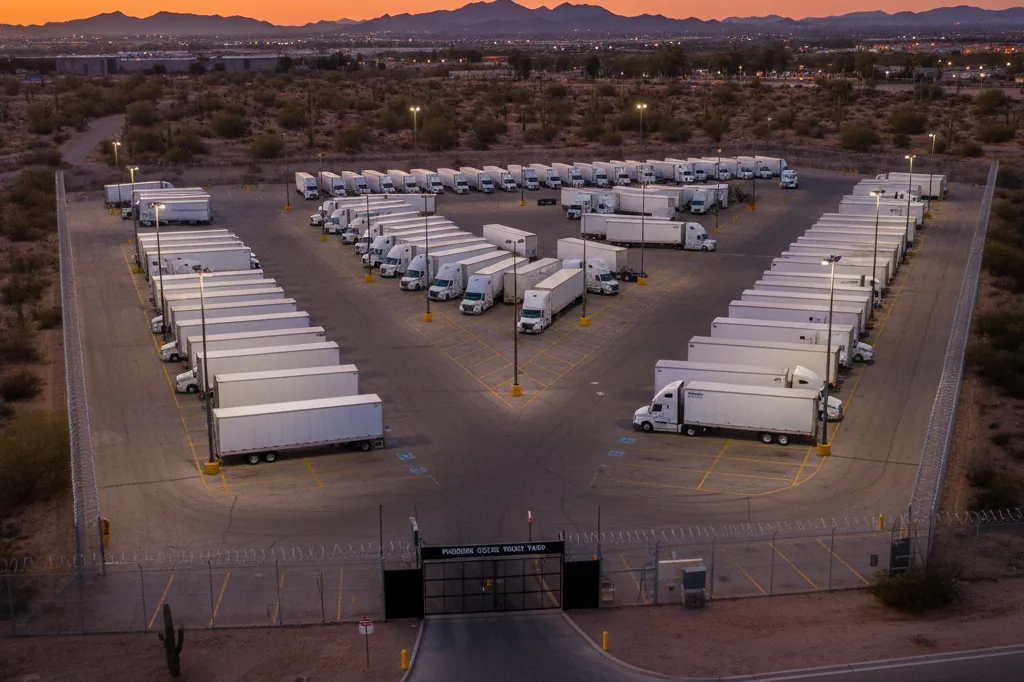
Paddock Parking’s Phoenix operations combine multiple physical and technological safeguards with driver-focused amenities and strategic placement to offer reliable, always-available industrial outdoor storage. The company’s local expansion in October 2025 added a secure outdoor storage yard on Washington Street, emphasizing investment in Phoenix’s logistics infrastructure. Facility-level protections include a 24/7 monitored live camera stream, automated motion-activated lighting, individual renter codes for secure access, and an 8-foot fence with barbwire supported by automated gates to control ingress and egress. Nearby secure outdoor storage in Phoenix highlights how sites positioned near major routes strengthen driver safety and reduce travel inefficiencies. On-site conveniences—accessible water stations, dumpsters, and bathrooms—reduce driver downtime and support longer-term storage needs, while flexible leasing options (lease by acre, short-term, month-to-month) let businesses match space to demand. The yard’s strategic location provides direct access to I-10 and I-17 and is configured to accommodate semi-trucks, trailers, heavy equipment, containers, and RVs.
- 24/7 monitored live camera stream supporting remote verification and incident review.
- Automated motion-activated lighting to deter after-hours activity and improve safe navigation.
- Individual renter codes to restrict and audit access per tenant.
- 8-foot fence with barbwire and automated gates providing physical perimeter security.
What Security Features Protect Your Commercial Vehicles?
Individual renter codes act as tenant-specific credentials that are issued and revoked on demand, making it simple to control who can enter the site and when, and supporting audit trails for access events. The live camera stream provides continuous visual coverage, enabling remote verification of suspicious activity and retaining evidence for investigations; integration with automated gates and alerting enables immediate operational responses. The 8-foot fence with barbwire and automated gates establish a deterrent perimeter, reducing opportunistic intrusions, while motion-activated lighting illuminates detected movement to discourage after-hours tampering and to improve driver safety during late arrivals. Together, these meronymous components—gates, cameras, lighting, renter codes—form a layered security architecture that reduces risk exposure and simplifies incident resolution.
How Does Location Near I-10 and I-17 Benefit Fleet Operators?
Proximity to major interstates like I-10 and I-17 shortens non-revenue miles and accelerates dispatch windows by placing staging and storage close to primary freight corridors, which reduces turn times and improves route efficiency. For regional distribution, being near these interstates enables more predictable travel times and easier access to both east-west and north-south routes in the Phoenix area, improving scheduling reliability for time-sensitive loads. Facilities within this local corridor provide faster access to nearby industrial zones and transport hubs, helping fleets cut idle time and streamline route transitions. Strategic placement also expands the geographic range for last-mile and regional pickup points without adding excessive deadhead costs, and it supports quicker turnaround for multi-stop runs that depend on centralized staging. For operators that prioritize on-time performance and lower transit waste, interstate adjacency translates directly into operational savings and improved service levels.
What Amenities and Facility Features Support Commercial Transport Storage?
Driver-focused amenities and thoughtfully designed facility features reduce operational friction, improve on-site safety, and contribute to long-term tenant retention by addressing practical needs during storage and staging. Elements such as on-site bathrooms, water stations, dumpsters, and clear signage support driver welfare and efficient site operations, while well-maintained surfaces, lighting, and dedicated maintenance zones keep equipment serviceable and accessible. Automated systems—lighting tied to motion sensors, gate automation, and credential management—lower operating costs while increasing safety and auditability. When assessing yards, fleets should prioritize facilities that bundle essential amenities with robust access controls to minimize off-site detours and maximize productive drive time. Similar design and layout factors are also emphasized in modern industrial storage facilities where functionality, accessibility, and safety define long-term performance.
This list outlines amenities that materially affect day-to-day operations and driver experience:
- On-site bathrooms for driver comfort and regulatory compliance during long waits.
- Accessible water stations to support vehicle servicing and driver needs.
- Dumpsters and site maintenance to preserve cleanliness and reduce maintenance downtime.
How Do On-Site Amenities Improve Storage Experience?
On-site bathrooms and water stations directly reduce time drivers spend off-site searching for basic facilities, helping them return to duty faster and maintain schedule integrity. Dumpsters and routine site maintenance improve safety and asset uptime by preventing debris-related damage and lowering the administrative burden of managing waste. Well-placed signage and marked circulation lanes speed maneuvering and reduce handling errors, which is especially valuable during high turnover periods. These operational conveniences improve driver morale and retention while delivering quantifiable time savings across repeated use, making amenities a practical productivity lever in yard selection.
What Role Does Automated Lighting Play in Safety and Accessibility?
Automated motion-activated lighting enhances both safety and energy efficiency by illuminating only active areas when movement is detected, which reduces energy consumption while dramatically improving visibility during night operations. When paired with surveillance systems, motion-activated lighting also creates a deterrent effect and enhances footage quality for incident review by reducing dark zones. From a maintenance perspective, selective lighting lowers burn-hours on fixtures and can reduce long-term service costs compared with constant illumination. The operational outcome is clearer entry/exit navigation, safer on-site work during off-hours, and a better-integrated security posture that supports 24/7 access without excessive energy overhead.
How Can Property Owners and Investors Partner for Industrial Outdoor Storage Development?
Property owners and investors can monetize underutilized land by partnering to develop industrial outdoor storage, capitalizing on local logistics demand with relatively low infrastructure requirements compared to enclosed warehousing. Partnerships typically involve an initial site evaluation to determine zoning feasibility and ground preparation needs, followed by modest investments in perimeter security, access controls, and surfacing to meet tenant expectations. Owners gain access to steady lease streams and reduced vacancy risk when land is repurposed for industrial outdoor storage, while operators bring tenant networks and management expertise that reduce the owner’s operational burden. In Phoenix’s growing market, the demand-supply gap for IOS creates an attractive context for owners who can move quickly through site validation, minor infrastructure upgrades, and tenant outreach.
Below are shared advantages that often make partnerships attractive to landowners and investors:
- Predictable lease income from long-term or recurring tenants.
- Low capital intensity compared with full industrial build-outs.
- Access to demand through established operators who generate tenant leads.
Property owners and investors can monetize underutilized land by partnering to develop industrial outdoor storage, capitalizing on local logistics demand with relatively low infrastructure requirements compared to enclosed warehousing. Partnerships typically involve an initial site evaluation to determine zoning feasibility and ground preparation needs, followed by modest investments in perimeter security, access controls, and surfacing to meet tenant expectations. Owners gain access to steady lease streams and reduced vacancy risk when land is repurposed for industrial outdoor storage, while operators bring tenant networks and management expertise that reduce the owner’s operational burden.
Details about partnership criteria and site coordination can be found on the contact page for those reviewing property readiness or planning upgrades. In Phoenix’s growing market, the demand-supply gap for IOS creates an attractive context for owners who can move quickly through site validation, minor infrastructure upgrades, and tenant outreach.
- Assess zoning and permitting constraints to confirm outdoor storage is allowable.
- Evaluate ground-bearing capacity and drainage needs to plan surfacing.
- Install perimeter controls and access systems to meet tenant security expectations.
- Formalize lease terms that reflect chosen models (by acre, spots, short-term).
What Are the Benefits of Partnering with Paddock Parking?
Partnering with Paddock Parking provides landowners access to a lead-generation and management hub that matches industrial outdoor storage sites with commercial tenants, enabling faster occupancy and simplified operations. The company handles tenant acquisition and security provisioning while offering flexible leasing structures that can be tailored to owner preferences, reducing the administrative burden on property owners. Operational management, including security systems and on-site amenities, is provided to meet commercial expectations and keep assets attractive to fleets. These partnership elements accelerate monetization timelines and reduce vacancy risk by leveraging Paddock Parking’s local market presence and service model.
How Does Industrial Outdoor Storage Development Support Phoenix’s Growing Market?
Industrial outdoor storage meets rising logistics demand in Phoenix by providing nearby staging and storage close to major freight routes, helping carriers and contractors reduce non-productive travel and improve regional distribution efficiency. Market drivers include increased e-commerce fulfillment activity and expanded regional freight tonnage that place pressure on existing warehouse capacity, creating spillover demand for secure outdoor storage solutions. For investors, IOS development offers a pragmatic way to respond to supply constraints without the higher capital intensity of enclosed warehouse construction, while delivering steady lease income and flexibility to adapt to evolving logistics patterns. In Phoenix, proximity to I-10 and I-17 amplifies these advantages by positioning storage yards where they deliver the most operational value to regional fleets.


